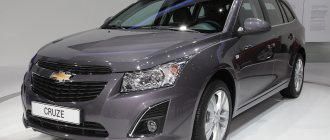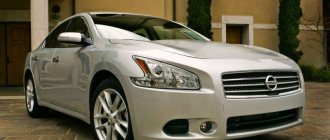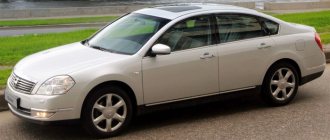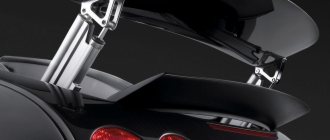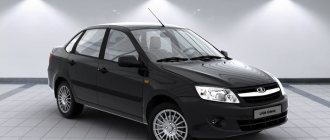Appearance
The exterior of the outgoing G-S was created by blowing away everything unnecessary in a wind tunnel. The resulting silhouette did not become the height of design thought, but it was absolutely recognizable, and this is a very important aspect when you are going to receive additional money from clients for the notorious “premium”.
With a new car everything is different. It was created not by aerodynamic engineers, but by sculptor artists. The emphasis is on the front part, all in German (more precisely, Ingolstadt) fashion. The relief of the radiator grille flowing onto the front bumper is aggressive enough to immediately run to the rear and look down - is there a diffuser “comb” there? Yes, my dear! But it looks more like a hint of aerodynamics than a truly useful element. Which, however, does not exclude real benefits.
Now let's turn the new GS into profile. And what? Before us is still the same silhouette - only the rear door opening has changed. The curve of the roof, the shape of the rear pillar, the plastic of the wings - everything is exactly like the model of the previous generation. As a result, the new Lexus looks not like a harmoniously developed athlete, but like a “daddy” who pumped up his biceps, but was too lazy to remove his beer belly.
Interior, seating comfort and capacity
The interior of the previous generation car was deliberately spacious. Both the overall architecture and the inter-seat plane, along which the lonely automatic selector wandered crookedly, worked for this feeling. A large screen reigned on the center console, on which both the driver and the passenger could easily “touchscreen” everything they needed.
In the new car, the screen has soared into the mountain heights - under the windshield - and it is absolutely impossible to reach it. Therefore, the driver was armed with a device - a “remote-touch” manipulator. If earlier (for example, on the RX model) it resembled a child from the incestuous marriage of a mouse with a joystick, now the control part does not deviate anywhere, but slides in four directions. It has become a little easier, but has not become clearer: hitting the virtual “buttons” on a large screen (8 or 12.5 inches, depending on the configuration) is inconvenient, and the screen itself does not please with polished graphic solutions.
Lexus GS III 3.0 AT (231 hp) 4×4
Until recently, I considered the top version of the BMW fifth series to be the standard business class sedan. After talking with the GS 430 last year, I realized that the Japanese are preparing a revolution in this personal system of automotive values.
Until recently, I considered the top version of the BMW fifth series to be the standard business class sedan. After talking with the GS 430 last year, I realized that the Japanese are preparing a revolution in this personal system of automotive values. And so, by releasing a new hybrid, they overthrew my personal king. What a pleasure it is to deal with the flagship of the GS line! It is the perfect embodiment of the Japanese concept of L-finesse, which offers the idea of perfection in everything - in design, quality, technology and even the feeling of a person communicating with the car. So, the GS 450h is good in all respects. An excellent chair covered in expensive leather takes me into a tight embrace. There is not a single surface in the cabin that is not pleasing to the eye and hand. The architecture of the front panel and door sections is light and dynamic, and the high window sill shields passengers from the outside hustle and bustle. Light colors make the interior more attractive (the GS 430, for example, was predominantly black inside). Perfection gives birth to harmony – it is easy and pleasant to find in the GS 450h. I press the start button, the optitron devices come to life, and the air conditioning turns on. What soundproofing is there! According to this indicator, the Japanese hybrid surpasses all the cars presented in this issue of the magazine. And it’s not just about the silent electric powertrain, of course. While the internal combustion engine is silent, the electric motor comes into play, and the GS 450h takes off with a pressure that you cannot expect even from 12-cylinder giants. You can’t argue with physics - even the most powerful engine takes time to spin up, but here all Newton meters (but not forces) are available from the first revolution. A curious detail is that the electric motor spins up to almost 15,000 rpm. I press harder on the accelerator pedal, and somewhere in the depths of the engine compartment (if you believe the rumor, about five meters down) a 3.5-liter V6 wakes up. Its thrust immediately merges with the electric one to give the car even more powerful acceleration. The V6 starts and turns itself off. For example, if the car is not warmed up, then at the first start it works. While driving (when the battery is charged and there is no need to work on the generator), the internal combustion engine always stalls as soon as the intensive acceleration phase ends, and it becomes possible to recover energy during braking. Even the most modern gasoline unit looks archaic compared to the electric one - silent and delivering maximum torque at lightning speed. However, we must admit that the Japanese 3.5-liter V6 (296 hp and 368 Nm) is one of the best engines today, one of the most economical and technologically advanced. It has twin-injection direct injection for each cylinder, variable valve timing on the intake and exhaust. In addition, the air conditioner is driven by electricity rather than a traditional belt, which reduces the load on the motor. There is a chain in the gas distribution system, this is an additional guarantee of reliability and durability. The electric motor has 200 hp. and 275 Nm. Together, these power units produce not 500 horsepower, as one might assume, but 345. The capabilities are limited by the battery capacity. The GS 450h is the world's first hybrid business class sedan with a longitudinally mounted power unit and rear axle drive. The internal combustion engine works in conjunction with an electric motor, a generator (which also acts as a starter), a power split device (power split device, operates on the principle of a planetary gear and distributes power flows in the ICE-electric motor-generator chain) and a two-stage gearbox that changes the value of the main transfers. “Hybrid” energy is transmitted to the wheels by an electronically controlled continuously variable transmission E-CVT, which simulates six fixed gears just in case. Despite the multi-component nature, the unit is very compact - only 10 mm longer than the 6-speed gearbox of the small IS sedan! An indispensable assistant for this entire team is a 288 V nickel-metal hydride battery located directly above the rear axle of the car, which, among other things, ensures ideal weight distribution along the axles. Acceleration pins riders down immediately after the start and doesn’t let go until the car reaches its rated speed of 250 km/h. You can, of course, enable manual switching mode. But you can’t call it anything other than pampering. Fixed stages are switched unnoticed by the driver, and only the numbers that light up in the information display indicate that the mode is in effect. However, for dynamic driving it would still be better to move the selector to the manual shift position, since this switches the transmission to sport mode. The GS 450h, like the GS 430, has a Variable Gear Ratio Steering System (VGRS). It operates softly and unobtrusively, while the sharpness of the steering wheel varies quite significantly - from 2.7 to 3.7 turns from lock to lock. The electric amplifier, which regularly generates the necessary feedback, deserves special praise. The car's arsenal includes shock absorbers with variable degrees of stiffness, having two operating modes. The first one is a little more comfortable. Lexus is becoming more tolerant of bad roads, but it still handles bumps resiliently and very well. The second is sports. When it is engaged, the car's handling becomes a special treat. Shaking riders over bumps, the sedan fulfills every whim of the driver with lightning speed and without delay. He readily dives into slow turns and superbly traces high-speed curves. Managing it is the height of bliss! However, I’ll make a reservation: I would rather call the GS450h’s suspension stiff, aimed at an active driver. There is no trace of the imposing comfort characteristic of many business-class sedans. Therefore, you should not “get lost” without clearing the road. In addition, there is a risk of damaging the elegant 18-inch wheels with low-profile tires (245/40). Safety is monitored by a non-switchable integrated VDIM system, which not only brakes the wheels and cuts off traction, but also steers at small angles for the driver when necessary, working proactively. However, we are well familiar with this system from the GS 430. Well, about efficiency (what was it all about?). On the highway at high speed, fuel consumption is comparable to that of gasoline competitors of similar power. Miracles don’t happen - the battery is discharged, and the engine needs to not only pull the car forward, but also recharge the battery and power the car’s systems. However, in a mode where acceleration alternates with braking, the hybrid installation reveals its talents. Average fuel consumption is melting before our eyes. Of course, it is unlikely that the ideal figures stated in the passport will be achieved, but the savings in urban traffic are obvious. If we compare, again, with 8-cylinder competitors, Lexus is far ahead in terms of efficiency. The recommended retail price of the car in Russia is $78,500. Just for fun, look at how much European top sedans in this class cost. But the GS 450h gives the owner much more than they do. Therefore, the popularity of the car is predetermined. In Europe, for example, the GS accounts for 21% of all Lexus sales. With the release of the GS 450h, the Japanese plan to increase this figure by 12%, and among all GS sold, the share of hybrids, according to their assumptions, will be 29%. I think Russia will not stand aside. The RX 400h was a great success, and the GS Hybrid is an even better car. Prices and equipment For the GS 450h, dealers are asking $78,500. The car has only one equipment, which includes R18 wheels, xenon headlights with adaptive lighting system, headlight washers, LED brake lights, rear spoiler, remote door opening system, leather interior and multifunction steering wheel, electrochromic electrically adjustable and heated mirrors, electric drive, heated and ventilated front seats, cruise control, multifunctional touch-screen display, bluetooth, separate climate control, Mark Levinson audio-video system (14 speakers), rain sensor, electric rear window curtain, which lowers itself when reversing, immobilizer, alarm, front, knee and side airbags, variable suspension system (AVS), ABS, EBD, Brake Assist, traction control, exchange rate stability control (VSC), VDIM, electric power steering ( EPS), VGRS.
Lexus-GS, from RUB 1,730,000.
If the numbers are to be believed, the driver's workplace is now tighter. In fact, this is not so - it’s just that the GS now seems to be hugging the pilot. Or the helmsman - the large steering wheel and the general architecture of the interior evoke associations with the cockpit of a boat or motor yacht, and the location of the buttons on the center console resembles other German cars.
Well, the guests of the sofa, as before, have nothing to complain about. The knees did not become tighter (an increase of 2 mm does not count), but the space above the head increased by as much as 20 mm.
To take or not to take
Restyling of the second generation Lexus GS 300 is a great car, especially for young people. It attracts attention and stands out in traffic, and despite its advanced age, it causes a minimum of problems. But, like any other premium car, it will require investment in maintenance. If this doesn’t scare you, feel free to take a business sedan, even if it’s from the past.
Author: Vitaly Kulchitsky
What do you think of the Lexus GS 300? What other business sedans do you like? Leave comments below the article.
Dynamics and efficiency
Unlike its predecessor, the new GS offers its potential owner the choice of one of only two engines - with a volume of 2.5 or 3.5 liters and a power of 209 and 317 horsepower, respectively. Both are new and both have V6 configurations, but neither has the power of the 3.0-liter unit that opened the line for the third-generation model. The new car does not yet have a bonus in the form of a 347-horsepower version of the GS460. The loss in “horses” did not affect the dynamics - thanks to the high torque and the correctly configured 6-speed automatic transmission.
The GS350 version, as before, is only available with all-wheel drive and, just like a generation ago, does not want to accelerate over 190 km/h.
Fuel consumption has been reduced, at least on paper. However, the ranges are still wide - the promised urban appetite is almost twice as large as the suburban one.
Problems and maintenance
GS 300 engines are reliable and not picky about our fuel, unless you run into gasoline with additives. They make the spark plugs mope. It’s especially a shame about the new kit: in order to get to the broken spark plugs, you will need to disassemble part of the intake tract.
The rear “multi-link” is durable. If you often drive a car, be prepared to replace wheel bearings after 60 thousand km and levers along with ball and silent blocks after 70-100 thousand km. The front suspension can easily travel up to 150 thousand km.
Automatic transmissions rarely break down, the main thing is not to forget to change the oil every 80 thousand km, unless, of course, you “drown” it at speed. A burning smell or cloudiness of the oil will indicate a premature replacement. In some models, automatic transmission fittings damaged by our salt may become sour. To prevent the problem, you need to treat them with anticorrosive. The poly V-belt of the box is cracking due to age.
When purchasing, pay attention to the lower door trims. These areas may be covered with rust resulting from the chemicals used on our roads. It would be a good idea to check the door seals. If they were not coated with silicone grease, you will notice cracks caused by freezing to the thresholds.
Parts for the “oldies” are not difficult to find. It is compatible with Toyota parts.
Also read: What kind of damage should you not buy a car with?
Budget
Oddly enough, the entrance ticket to the “GS country” did not become more expensive with the change of generations, but on the contrary, it became more affordable. However, thanks for this should be given to the relatively modest engine of the GS250 version. This motor, however, more than copes with the job; and in the basic configuration, compared to the previous generation car, there are no parking sensors. But there is a rear view camera in place, the resolution of which has been increased - raindrops hanging from the trunk lid are now visible in all their splendor.
The basic GS250 costs 1,730,000 rubles - 217 thousand less than the three-liter car of the previous generation. The all-wheel drive version of the GS350 (and the other, let us remind you, simply does not exist) costs at least 2,210,000 - and this is again less than in the recent past, by as much as 39,000 rubles.
Lexus GS III trim level
The standard version of the GS III 2007 included aluminum wheels R17, xenon optics, an electric sunroof, a keyless entry system, leather trim, climate control, and electric adjustments for the front row of seats. By default, the updated sedan was equipped with a proprietary audio system with a 6-disc changer and 10 speakers. On 2010 models, the audio system received Bluetooth functionality.
Options included 18-inch wheels, a premium ML audio system, a navigator and a rear view camera.
Safety
The Lexus GS is not a very relevant car for Europe, and therefore the hands of the EuroNCAP testers have not yet reached it. You can only look at the crash test results of the third generation G-S and find an overall rating of five stars. In the “child protection” category, the sedan earned four stars, which is also very worthy. There will probably be no questions about the new generation car either: the body architecture is identical to its predecessor, and the same ten airbags protect the occupants of the cabin, including knee protection for both front passengers.
Lexus-GS, from RUB 1,730,000.
WE DECIDED:
Lexus GS, as before, offers almost a full range of automotive benefits already in the basic version, which has also become pleasantly cheaper. Despite borrowing some design solutions from competitors, the car remains recognizable and does not cause a condescending smile. Unless, of course, you believe in ghosts.
Lexus GS: comparing old and new
Poor choice and problems on the secondary market
Restyling of the Lexus GS 300 II is rarely found on the secondary market - only 16 offers in Russia. The cheapest option from 2000 costs 330 thousand rubles:
For the most expensive copy of 2003. asking for 650 thousand rubles:
Although the range of Lexuses is not very diverse, it is easy to get lost in two pines. We found a 2001 model. with mileage 295 thousand km:
A check through avtocod.ru showed that the car is being sold with an incorrect mileage, traffic police restrictions and a duplicate title:
The duplicate was issued because there was no space left in the original document to make entries: in 17 years the car had 17 owners.
The last seller's mileage was as much as 147 thousand km:
Also, the car has traffic police restrictions, due to which it will not be possible to re-register the car in your name.
Also read: 8 most common mistakes when buying a car

